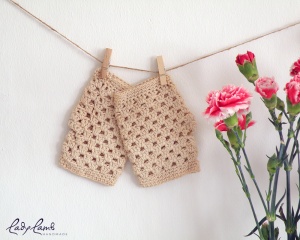In this post I will talk a little about yarns that we use to knit and crochet, with a focus on sustainability, and then I will tell you my opinion about it, but remember, this is a personal opinion and many people may think different about it. Also this is a much more complex subject than one might think, and nothing is just black or white.
—-  LONG POST AHEAD WARNING
LONG POST AHEAD WARNING  —-
—-
Yarns and threads are divided in 2 big groups, the synthetics and the naturals.
The most common synthetic fibres found in yarns are acrylic, nylon and polyester. Nowadays these can be quite soft and resemble wool, or they can give us textures that we don’t get with natural yarns. But, what these fibres have in common is that they are all petroleum based, and we all know the awful impacts that has on the environment.
On the other hand we have the natural fibres, that can be divided into animal fibres or plant fibres. The animal fibres can be:
– wool – Wool is derived from the fur or hair of animals like sheep, goats, llamas and rabbits. These can be very soft and wonderful to work with. Even if you’re allergic and feel they are itchy, you have the choice of using merino or alpaca wool which are naturally hypoallergenic. Of course if we think about it, these also have some impact on the environment. Green house gas production, the way some animals are kept and treated…
– silk – this is a luxurious fibre that’s strong but at the same time soft and delicate and naturally shiny. But guess what… the silk worms are killed in the process.
And this take us to plant fibres. There is a big range of plant fibres being used for yarns, the most common are cotton and linen but nowadays is getting easy to find also, hemp, soy, bamboo or banana silk. These are strong fibres and can give some nice textures to our knitted/crochet projects. At the first glance, these appear not to have the downsides of the synthetics or wools and be completely environment friendly, but are they? As I told you before nothing is black and white, and the truth is that most plantations of these plants use lots of chemicals that are harmful for the environment and animals.
And if you want to add an extra, many yarns (synthetic or natural) are dyed using harmful chemical dyes. So what should we do?
My opinion is that these are crazy times we are living in, where it appears to be nothing we can do without having some negative impact on our world. Of course the best choice would be to buy eco-friendly organic natural hand-dyed yarns, but lets be real, it’s not everyone who can pay $30 to $80 (or more) for a single skein of yarn. But still, there are some eco-friendly yarns that are also wallet-friendly. Personally I will do my best to use natural yarns even if they can’t always be completely organic. I believe that this is still a better choice than synthetic yarns. And even if they aren’t completely eco-friendly, we can choose from companies (or small businesses) that show they care and take some actions to make their production process more sustainable and help small communities. Here are some examples:
– Rosários 4 – is a Portuguese brand that shows that is concerned with the environment and now has several natural yarns available at wonderful prices. Some of them are Bio-wool, Bio-bamboo naturally dyed, re-use which is made from recycled cotton, and for example, Wollyboo which is made with natural fibres, spun without chemicals and dyed with natural dyes, and a 50g ball of this yarn costs around €3 (can’t get cheaper than that!!!). The downside, the official company website don’t have an online shop and it’s not easy to find some of their yarns.

– then we have the example of an online shop Retrosaria Rosa Pomar, which has been working personally with small communities to bring us natural yarns that are still produced in a traditional way, like Bucos.

– a more famous brand would be for example Malabrigo. They produce 100% merino wool yarns that are hand-dyed and show concernment for the environment.

I could give more examples of online shops and yarn brands but I believe this post is already long enough.
*just to make notice that I’m don’t have any connection with these brands and I don’t receive samples or am asked to make reviews. If I want to work with their yarns I have to buy and pay for them like anyone else





 LONG POST AHEAD WARNING
LONG POST AHEAD WARNING 








